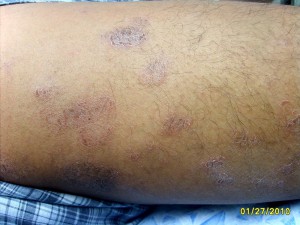Eczema
Parul Kathuria, MD and Roopal V. Kundu, MD

Photo: Courtesy of Kesha Buster, MD
Eczema is a common skin disorder seen worldwide and in the United States. It usually presents as dry, itchy, red or darker areas of skin. Sometimes referred to as “the itch that rashes”, the term eczema is used interchangeably with dermatitis, which literally means inflammation of the skin. In people with skin of color, eczema often appears “ashen”, brown, or grayish in color. Eczema is the second most frequent skin disease in African Americans and is one of the most common skin disorders seen in infants and children overall. 1,2
There are several types of eczema or dermatitis, some of which are discussed below:
Atopic Dermatitis:
(a.k.a. atopic eczema), often used synonymously with eczema, is a disease of unknown cause. It usually starts in infancy3 and is characterized by itchy, scaly lesions, xerosis (dry skin), and lichenification (accentuation of skin markings). Atopic dermatitis is commonly associated with other atopic diseases such as asthma or allergic rhinitis.4 The frequency of atopic dermatitis appears to be increasing4 and appears to be more common among Blacks, Asians, and Pacific Islanders.3 In infants, eczema is usually seen on the forehead and cheeks. In children, eczema is seen on the hands, wrists, ankles, feet, and elbow and knee creases. In adults, eczema is usually seen on the face, neck, upper arms and back, elbow and knee creases, and back of the hands, feet, fingers, and toes.2
Nummular Dermatitis:
(a.k.a. nummular eczema) appears as itchy “coin-shaped” areas of inflammation and can be crusty or scaly.
Xerotic (asteatotic) Eczema:
(a.k.a asteatotic eczema), in this type of eczema, extremely dry skin becomes inflamed and may require treatment beyond moisturizers.
Contact Dermatitis:
in this form of eczema, skin irritation can form from excessive contact with irritants (e.g., soap, detergents, harsh chemicals) and allergens (e.g., poison ivy, nickel, fragrances, etc.)
Eczema can also look different in darker skinned patients. Some of the unique forms of eczema seen more commonly in darker skin include papular eczema (bumps) and eczema with follicular prominence.3
A major concern for people of color is the skin discoloration associated with eczema. Eczema or scratching secondary to the itch of eczema can lead to darkening (hyperpigmentation) or lightening (hypopigmentation) of the skin. This discoloration can last for months to years, even after the eczema is treated3. Darkening of the skin is especially visible in children with skin of color. If the patient’s underlying eczema and inflammation is treated, however, the changes in skin color can be improved.2
What is the cause of Eczema?
The cause of atopic dermatitis and many forms of eczema is unknown but is potentially due to a dysfunction in filaggrin, a protein that maintains the membrane of skin cells.5 It is also thought that genetics (inheritance) and an improperly functioning of the local immune system contribute to the development of atopic dermatitis. Environmental factors also likely play a role. Atopic dermatitis tends to be more common in industrialized nations and urban areas, and the incidence appears to be increasing in developing nations as they become more Westernized.3 Xerotic eczema is due to very dry skin. In contact dermatitis, an irritant or allergen directly causes the rash. However, in many cases of allergic or irritant contact dermatitis, a clear trigger cannot be found.
How do I know if I have Eczema?
Eczema is usually diagnosed clinically. Direct physical examination and taking of a medical history allow dermatologists to accurately recognize the different forms of eczema. They may also ask about family history of eczema and associated diseases.
How is Eczema treated?
There are many helpful, easy ways to treat or soothe eczema. The first step is to avoid irritants or allergens, to which your body may react. Vigilant moisturization is the mainstay of treatment of atopic dermatitis1 and is also quite helpful in other forms of eczema. Gentle skin care is also recommended:
- Avoid extremely hot or extremely cold showers/baths
- Avoid fragrances (perfumes, colognes, cleansers, detergent, etc.)
- Avoid other irritants such as tight-fitting clothing. If a patient with eczema also has food allergies, avoiding those foods may help resolve eczema symptoms.6
- Bathe for 5-10 minutes with a gentle cleanser no more than once daily followed by patting skin dry and immediately moisturizing the skin
- Use bland, fragrance free emollients (moisturizers) at least daily. Ointments and creams are best. For active flares of eczema, placing a lukewarm, clean cloth on the affected area or soaking in lukewarm water can help to soothe the itch. An emollient MUST be applied immediately after removing the cloth or exiting the bath.
- Take baths with rice starch added to the bath water or bleach baths using one quarter cup of bleach for a half-full bath or one half cup of bleach for a full bath. Immediately apply moisturizers after these baths.6
- Avoid using alternative medicines such as herbal therapy, vitamins, naturopathy, traditional healing, homeopathy, and Ayurveda. These treatments may have allergens and irritants that can trigger an eczema reaction.7
A dermatologist may also prescribe a topical corticosteroid. These steroids help with both acute and chronic eczema and help to reduce inflammation.6 Eczema, especially atopic dermatitis, is often secondarily infected, so your dermatologist may also prescribe antibiotics or anti-bacterial cleansers to treat any associated infections. Rarely, in severe cases, eczema is treated with systemic medications that alter the immune system.
Download Spanish translation.
Descarga traducción en español.
Additional Resources
American Academy of Dermatology
References
1. Halder, R.M., Grimes, P.E., McLaurin, C.I., Kress, M.A., & Kenney, J.A. (1983). Incidence of common dermatoses in a predominantly black dermatologic practice. Cutis, 32, 388-390.
2. Spergel JM, Paller AS. Atopic dermatitis and the atopic march. The Journal of allergy and clinical immunology. 2003;112(6 Suppl):S118-27.
3. Desai, N., & Alexis, A.F. (2009). Atopic Dermatitis and Other Eczemas. In A.P. Kelly & S.C. Taylor (Eds.), Dermatology for Skin of Color. China: McGraw-Hill.
4. Kang, K., Polster, A.M., Nedorost, S.T., Stevens, S.R., & Cooper, E.D. (2008). Atopic Dermatitis. In J.L. Bolognia, J.L. Jorizzo & R.P. Rapini (Eds.), Dermatology (2nd ed.). Spain: Mosby.
5. Dermatology atlas for skin of color. New York: Springer; 2014.
6. Boguniewicz M, Eichenfield LF, Hultsch T. Current management of atopic dermatitis and interruption of the atopic march. The Journal of allergy and clinical immunology. 2003;112(6 Suppl):S140-50.
7. Silverberg JI, Lee-Wong M, Silverberg NB. Complementary and alternative medicines and childhood eczema: a US population-based study. Dermatitis : contact, atopic, occupational, drug. 2014;25(5):246-54.

Cutis Journal
Read published peer-reviewed articles written your by Skin of Color Society members

Did You Know
Skin of color patients comprise the majority in California, New Mexico and Texas…and soon will be the majority in Arizona, Nevada, Georgia, New York and Florida.
By 2042, more than 50% of the US population will have skin of color.




